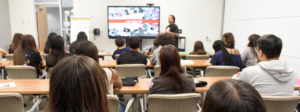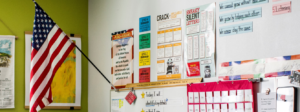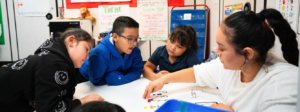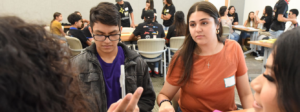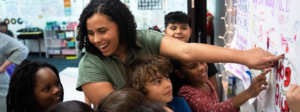The unrelenting cases of police brutality against Black people have reached a point where a critical mass of white Americans have finally joined communities of color in going out into the streets to say “enough.” The overwhelming show of energy and solidarity has, heartbreakingly, not been sufficient to stop the brutality. But we are seeing signs of progress, driven by everyday people and building off work that has been going on for decades: statues of racist traitors who took up arms against our country finally coming down, chokeholds being banned, police departments being restructured, funding being diverted from police departments to social services.
Advocates and protestors are also demanding changes in K-12 education—mainly that school districts sever ties with police departments that supply officers to patrol many of our public schools. This is a good idea: police presence in schools contributes to the broader overpolicing of Black youth, and the perpetuation of the school-to-prison pipeline in which students of color are much more likely to be suspended and referred to the criminal justice system, with terrible effects on their success in school and in life. Reversing the school-to-prison pipeline will require more than just removing police officers from schools, though: we’ll need strategies around safety and security that include investment in training and support for teachers on the role bias plays in discipline and ways to de-escalate conflict with students; clear policies for school staff about when—and when not—to make referrals to law enforcement; and increased connections between schools and local organizations who offer social/emotional supports.
But discipline policies are just the tip of the iceberg of racism in public education. Most Americans excuse shameful racial inequities in educational outcomes—standardized test scores, graduation rates, and college readiness rates—as a symptom of the systemic racism outside of schools. We’ve given schools an impossible task, the thinking goes, to make up for the poverty, lack of access to health care, and other obstacles students of color disproportionately face.
While challenges outside the classroom can obviously make schools’ jobs more difficult, there’s much more to the story. The truth is that schools and school systems don’t just grapple with the effects of systemic racism; they actively perpetuate it. Racism in schools sometimes manifests itself in ways that can be easily captured on video, when a young black girl is thrown to the ground by a white security officer or when a white teacher tells a Latinx student to go back to where they came from.
But usually it’s more pernicious, operating in quiet ways that still have profound effects on children. You see it in teacher preparation and hiring, where we create certification rules that prioritize factors like the size of a candidate’s checking account and their test-taking ability over whether their students learn and grow, and where lily-white preparation programs continue to be accredited without a peep of protest from regulators. The result is a national teacher workforce that’s 80% white serving a student body that is 50% students of color, despite the growing body of research showing that teacher diversity can boost students’ success. Many students of color will see no teachers who share their racial or ethnic background during their entire K-12 career.
You see it in access to gifted and advanced classes, where high-achieving Black students get those placements at half the rate – half the rate! – of their high-achieving white peers.
You see it in the backwards way we fund education, based largely on local property taxes, ensuring that schools serving lower income communities won’t offer their students the same staffing or facilities or enrichment as students in affluent communities.
Perhaps most importantly but least understood, you see it in the opportunities students get—and don’t get—in their classrooms every day. In our 2018 study, The Opportunity Myth, we found that students of color, regardless of their achievement level and potential, are far less likely to have grade-appropriate assignments, strong instruction, and teachers with high expectations—all crucial to helping them graduate ready for success in college and beyond. And the opportunity gaps are huge: classrooms with mostly white students were 3.5 times more likely to receive strong instruction and 1.5 times more likely to have grade-appropriate assignments. High-achieving students of color were 30% less likely to get grade-appropriate assignments than their white counterparts. These yawning opportunity gaps are the manifestations of systemic racism deeply ingrained in our schools despite the dedication and caring school staff have for their students.
But because none of these racist policies and practices lend themselves to 15-second videos or sound bites, they rarely spark flashpoints of public protest and fly below the radar of those in power, even as students of color call out the problem.
TNTP has been fighting for equity in public education for more than two decades, alongside civil rights organizations, local advocates, parents, students, and educators—and standing on the shoulders of a long line of leaders and organizations that came before us, learning and growing as we go. In the months and years ahead, that fight will mean calling on leaders and educators to confront all the ways systemic racism shows up in our schools—not just in relationships with police departments, but in the inequitable experiences and opportunities schools provide to students of color.
These are hard truths to call out, not least because of the understandable reluctance to criticize important neighborhood institutions to which we entrust our children, staffed by people we respect and admire. But without confronting this uncomfortable reality, we will end up knocking down one wall of an edifice riven with racism, instead of rooting out the scourge down to the foundation.


